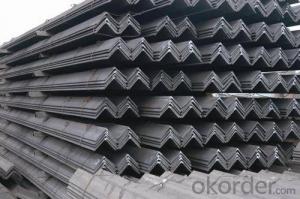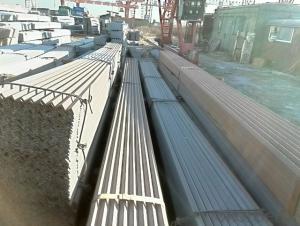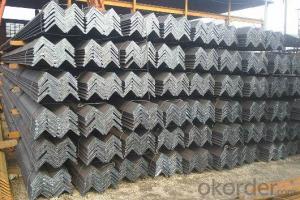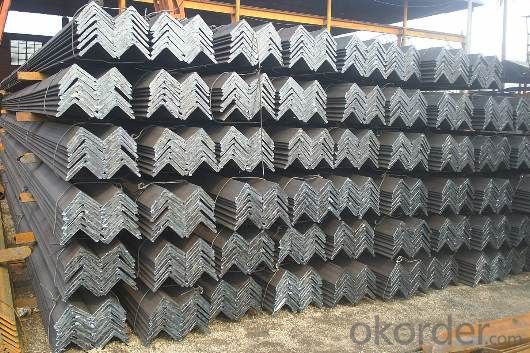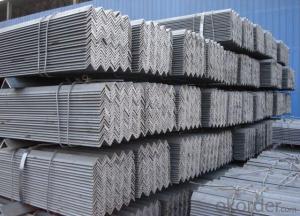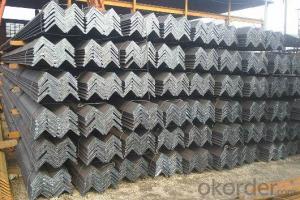Hot Rolled Steel Angles with Good Quality
- Loading Port:
- Tianjin
- Payment Terms:
- TT OR LC
- Min Order Qty:
- 25 m.t.
- Supply Capability:
- 20000 m.t./month
OKorder Service Pledge
OKorder Financial Service
You Might Also Like
Product Description:
OKorder is offering high quality Hot Rolled Steel Angles at great prices with worldwide shipping. Our supplier is a world-class manufacturer of steel, with our products utilized the world over. OKorder annually supplies products to European, North American and Asian markets. We provide quotations within 24 hours of receiving an inquiry and guarantee competitive prices.
Product Applications:
Hot Rolled Steel Angles are ideal for structural applications and are widely used in the construction of buildings and bridges, and the manufacturing, petrochemical, and transportation industries.
Product Advantages:
OKorder's Hot Rolled Steel Angles are durable, strong, and resist corrosion.
Main Product Features:
· Premium quality
· Prompt delivery & seaworthy packing (30 days after receiving deposit)
· Corrosion resistance
· Can be recycled and reused
· Mill test certification
· Professional Service
· Competitive pricing
Product Specifications:
Manufacture: Hot rolled
Grade: Q195 – 235
Certificates: ISO, SGS, BV, CIQ
Length: 6m – 12m, as per customer request
Packaging: Export packing, nude packing, bundled
Sizes: 25mm-250mm | ||
a*t | ||
25*2.5-4.0 | 70*6.0-9.0 | 130*9.0-15 |
30*2.5-6.6 | 75*6.0-9.0 | 140*10-14 |
36*3.0-5.0 | 80*5.0-10 | 150*10-20 |
38*2.3-6.0 | 90*7.0-10 | 160*10-16 |
40*3.0-5.0 | 100*6.0-12 | 175*12-15 |
45*4.0-6.0 | 110*8.0-10 | 180*12-18 |
50*4.0-6.0 | 120*6.0-15 | 200*14-25 |
60*4.0-8.0 | 125*8.0-14 | 250*25 |
FAQ:
Q1: Why buy Materials & Equipment from OKorder.com?
A1: All products offered byOKorder.com are carefully selected from China's most reliable manufacturing enterprises. Through its ISO certifications, OKorder.com adheres to the highest standards and a commitment to supply chain safety and customer satisfaction.
Q2: How do we guarantee the quality of our products?
A2: We have established an advanced quality management system which conducts strict quality tests at every step, from raw materials to the final product. At the same time, we provide extensive follow-up service assurances as required.
Q3: How soon can we receive the product after purchase?
A3: Within three days of placing an order, we will begin production. The specific shipping date is dependent upon international and government factors, but is typically 7 to 10 workdays.
Images:

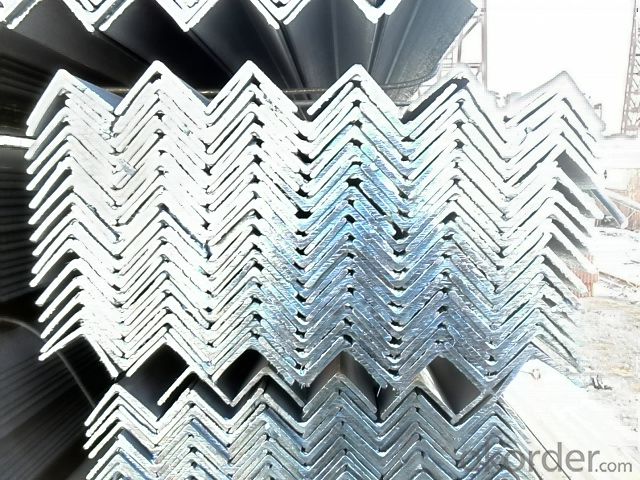

- Q: Can steel angles be used in solar panel mounting systems?
- Yes, steel angles can be used in solar panel mounting systems. Steel angles are often chosen for their strength, durability, and stability, making them suitable for supporting the weight of solar panels. They can be easily fabricated and customized to fit specific project requirements. Additionally, steel angles provide a stable base for solar panels, ensuring proper alignment and reducing the risk of damage due to wind or other external factors. However, it is important to consider the specific requirements of the solar panel system and consult with a structural engineer or a professional installer to ensure that the chosen steel angles meet the necessary load-bearing capacity and structural integrity standards.
- Q: Can steel angles be used as supports for beams or columns?
- Yes, steel angles can be used as supports for beams or columns. Steel angles are L-shaped structural members made of steel that have a variety of applications in construction and engineering projects. They are commonly used as supports, especially for beams or columns, due to their strength and stability. Steel angles provide structural support by transferring the load from the beams or columns to the foundation or other structural elements. They are often used as brackets or braces to reinforce the beams or columns and prevent them from buckling or bending under heavy loads. The versatility of steel angles allows them to be easily welded, bolted, or otherwise connected to the beams or columns. They can be customized to fit specific project requirements, allowing for flexibility in design and construction. Additionally, steel angles are durable and resistant to corrosion, making them suitable for both indoor and outdoor applications. They are available in various sizes and thicknesses, enabling engineers and architects to choose the appropriate angle dimensions based on the load and span of the beams or columns. Overall, steel angles are a reliable and cost-effective choice for supporting beams or columns in construction projects, offering strength, stability, and versatility.
- Q: What are the different types of connections used for steel angles in commercial applications?
- There are several types of connections used for steel angles in commercial applications, including bolted connections, welded connections, and cleat connections. Bolted connections involve using bolts and nuts to secure the angles together, while welded connections involve fusing the angles together using welding techniques. Cleat connections involve using a separate piece of steel, called a cleat, to connect the angles together. The choice of connection type depends on factors such as the load requirements, design specifications, and ease of installation.
- Q: Are steel angles available in different lengths?
- Yes, steel angles are available in different lengths. Steel angles are commonly used in construction and manufacturing industries for various applications such as support structures, frames, and bracing. They are available in a range of standard lengths, typically ranging from 20 feet to 40 feet. However, it is also possible to find steel angles in custom lengths, depending on the specific requirements of a project. Different lengths allow for versatility and flexibility in design and construction, enabling engineers and architects to create structures that meet their specific needs.
- Q: What is the difference between the main keel and the angle steel and the channel steel?
- The boat in the boat, the boat is keel or load-bearing structure is the most important. It's at the bottom of the ship. On the keel, there is reinforcement across the ship's ribs. The bow and stern keel off the bow post. The keel is usually the first one to be part of the hull construction. The keel laying is the most important event in the shipbuilding process.
- Q: Galvanized steel angles under what conditions?
- Humid environment
- Q: Can steel angles be used for supports in construction?
- Certainly! Steel angles are indeed suitable for use as supports in construction. These versatile and strong components are commonly employed in construction projects to serve as structural supports. They find application in a wide range of uses, including supporting beams, columns, and frames. Steel angles are highly advantageous as they provide stability and rigidity to the structure, enabling them to support heavy loads and withstand forces like gravity and wind. Furthermore, they offer the convenience of easy welding or bolting together, ensuring a speedy and efficient installation process. All in all, steel angles are a favored choice for construction supports due to their durability, strength, and user-friendly nature.
- Q: What are the different grades of steel used for manufacturing steel angles?
- Manufacturing steel angles involves the use of various grades of steel. These grades include: 1. Mild Steel: This is the most frequently utilized grade for producing steel angles. It boasts a low carbon content and is reasonably priced. Mild steel angles are suitable for a wide range of applications and possess excellent weldability and formability. 2. High-strength low-alloy (HSLA) steel: This grade incorporates small quantities of alloying elements such as copper, vanadium, or niobium, which augment its strength and toughness. HSLA steel angles are commonly employed in structural applications that demand high strength and durability. 3. Stainless Steel: Stainless steel angles are crafted from alloys that contain a significant chromium content, offering outstanding resistance to corrosion. These angles find common usage in environments where corrosion poses a concern, such as coastal areas or chemical plants. 4. Carbon Steel: Carbon steel angles are comprised of a combination of iron and carbon, with carbon content typically ranging from 0.05% to 2.1%. The higher the carbon content, the stronger and harder the steel becomes. Carbon steel angles are frequently employed in construction and machinery manufacturing. 5. Alloy Steel: Alloy steel angles are created by introducing various alloying elements like manganese, nickel, chromium, or molybdenum into carbon steel. These additions enhance the strength, hardness, and resistance to wear and corrosion of the steel. Alloy steel angles find common usage in heavy-duty applications like mining equipment or industrial machinery. The selection of steel grade for manufacturing steel angles depends on the specific requirements of the application, including desired strength, durability, corrosion resistance, and cost considerations.
- Q: Where does channel steel use more? Where does angle iron use more?
- Hot rolled stainless steel light channel steel (YB164-63) hot rolled light channel steel is a kind of steel with wide legs and thin wall, which has better economic effect than ordinary hot rolled channel steel. Its specifications range from 5-40#. In 1966, standard specifications ranged from 10-40#. Main applications: building and steel structure etc..
- Q: What is the tensile strength of steel angles?
- The tensile strength of steel angles may vary depending on the grade of steel and the method of manufacturing employed. In general, steel angles exhibit a considerable tensile strength. For instance, commonly used grades like A36 possess a tensile strength ranging from approximately 58,000 to 80,000 psi. Nevertheless, higher strength steel grades like A572 or A588 can surpass 100,000 psi in terms of tensile strength. To ascertain the precise tensile strength of steel angles in a particular application, it is crucial to refer to the specifications provided by the manufacturer and the specific grade of steel.
Send your message to us
Hot Rolled Steel Angles with Good Quality
- Loading Port:
- Tianjin
- Payment Terms:
- TT OR LC
- Min Order Qty:
- 25 m.t.
- Supply Capability:
- 20000 m.t./month
OKorder Service Pledge
OKorder Financial Service
Similar products
Hot products
Hot Searches
Related keywords
